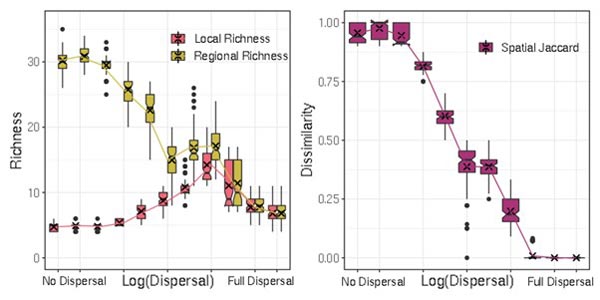Biodiversity Controversy
Postdoctoral Researcher Brennen Fagan discusses debates centred on biodiversity.

To not bury the lede, how much biodiversity is declining seems to depend on your data, and, of course, what data you use and your interpretation thereof depend on your values.
This might not seem controversial, especially given the fairly unified messaging around biodiversity loss and the importance of biodiversity in media (eg IPBES, expert consensus (Isbell et al., 2023), movies, tv episodes, or podcasts, including one first season Bill Nye episode from 1993). And yet, a few (reputable!) articles come out every year that cause a bit of controversy, resulting sometimes in comparisons to climate change denialism (Loreau et al., 2022). So what is going on under the surface?
The most recent controversy to come across my desk is a 2020 piece and its 2022 replies (Leung et al., 2020; Leung, Hargreaves, Greenberg, McGill and Dornelas, 2022; Leung, Hargreaves, Greenberg, McGill, Dornelas, et al., 2022a, 2022b, 2022c; Loreau et al., 2022; Mehrabi and Naidoo, 2022; Murali et al., 2022; Puurtinen, Elo and Kotiaho, 2022) (with commentary by a co-author on the original piece). The paper aimed to examine the form of the variation underlying reports of “catastrophic global declines in vertebrate populations” and came to the conclusion that“98.6% of populations across all systems showed no mean global trend” with the remaining “clusters” declining strongly with varying levels of certainty. As you can see from the cluster of replies cited above, the scientific community reacted fairly strongly to these conclusions, possibly because it appears to contrast with the unified message above.
Okay, so we have at least one team of scientists who oppose blanket statements of biodiversity decline (but still frame their article around loss, eg Figure 5), but we also have an apparent consensus that biodiversity is declining (Isbell et al., 2023) (to the point where the referenced paper’s biodiversity expert survey assumes loss rather than asking about change and letting loss be the dominant result). Can these two positions, that there is and might not be a global biodiversity decline, be simultaneously true?
Yes, and in multiple ways. As mentioned, Leung et al. started from a position of “is this trend true”, so they were trying to determine if both positions could emerge from the same data due to, eg, calculating summary statistics differently (2020). Another historical perspective emerges from the work of Mouquet and Loreau, who think about scales of diversity in relation to dispersal rather than change in annual growth rate (eg 2003 Figure 3). (Disclosure: my co-authors and I are working on a spiritual follow-up to this paper (Fagan et al., 2023).) This is easy to demonstrate in theory. If you introduce one new species to two sites that does not affect the other species at either site, then the local and regional aspects of diversity have gone up, but the two sites are now more alike than they were previously. If you instead moved some of one site’s species to the other, regional diversity hasn’t changed, while one site’s local diversity has increased and the other’s might decrease depending on how you calculate local diversity. The scale you are interested in has a definite effect on what story of biodiversity you see and that is something we need to be aware of.
 |
|---|
| Image adapted from pre-print (Fagan et al., 2023). |
We’ve now discussed two possibly obvious ways for the biodiversity story to be complex for the same data: clustered versus catastrophic declines (Leung et al., 2020) and different scales (Mouquet and Loreau, 2003; Fagan et al., 2023). As you might imagine, things get more complex when we consider different researchers working on different data sets. Consider three sets of researchers visiting the same site that is planned for conversion from one land use type to another, say a reforesting scheme of some pasture. Researchers A might see this and decide to compare with similar sites, say adjacent new-growth forest, while Researchers B might do the same for neighbouring pasture. Researchers C focus on just measuring things happening at the focal site.
This might seem strange, but each set of researchers could be equally valid and this is a primary difference between the PREDICTS and the BioTIME databases, and this is compounded by different measurements, such as the Biodiversity Intactness Index. If researchers A see forest species moving into the focal site, they might say it is becoming more biodiverse because it has more of the species they’re interested in. Researchers B, however, might see a decline in the pasture species that they are interested in. Of course, Researchers C might see the change but they also wouldn’t necessarily see the full(er) pool of species that A and B might. And no-one has funding to do everything, everywhere, and especially not all at once.
Coming up now for a breath of fresh air, where does that leave us? Everyone is measuring different things, valuing different things, and reporting generally a story of negativity but with sometimes drastically different degrees. There’s a reason for the consensus at the end: everyone is agreeing that things are changing and that it isn’t generally going in a way that’s favourable. I’ll echo Brian McGill: “some really big winners and some really big losers and a lot in between, and that’s bad – humans ARE massively modifying the planet in ways that all but the most biodiversity-hating people care about, and the extinctions we are causing are irreversible, so please don’t cite this blog as evidence that ‘everything is OK’.” So if you hear dissent regarding trends in biodiversity, the argument is probably about nuance. To echo some other LCAB members, “the devil is in the details”, but they seem to be there all the same.
Bibliography
Fagan, B. et al. (2023) ‘Increased dispersal explains increasing local diversity with global biodiversity declines’, bioRxiv. Available at: https://doi.org/10.1101/2023.06.09.544194.
Isbell, F. et al. (2023) ‘Expert perspectives on global biodiversity loss and its drivers and impacts on people’, Frontiers in ecology and the environment, 21(2), pp. 94–103. Available at: https://doi.org/10.1002/fee.2536.
Leung, B. et al. (2020) ‘Clustered versus catastrophic global vertebrate declines’, Nature, 588(7837), pp. 267–271. Available at: https://doi.org/10.1038/s41586-020-2920-6.
Leung, B., Hargreaves, A.L., Greenberg, D.A., McGill, B., Dornelas, M., et al. (2022a) ‘Reply to: Do not downplay biodiversity loss’, Nature, 601(7894), pp. E29–E31. Available at: https://doi.org/10.1038/s41586-021-04180-0.
Leung, B., Hargreaves, A.L., Greenberg, D.A., McGill, B., Dornelas, M., et al. (2022b) ‘Reply to: Emphasizing declining populations in the Living Planet Report’, Nature, 601(7894), pp. E25–E26. Available at: https://doi.org/10.1038/s41586-021-04166-y.
Leung, B., Hargreaves, A.L., Greenberg, D.A., McGill, B. and Dornelas, M. (2022) ‘Reply to: Shifting baselines and biodiversity success stories’, Nature, 601(7894), p. E19. Available at: https://doi.org/10.1038/s41586-021-03749-z.
Leung, B., Hargreaves, A.L., Greenberg, D.A., McGill, B., Dornelas, M., et al. (2022c) ‘Reply to: The Living Planet Index does not measure abundance’, Nature, 601(7894), p. E16. Available at: https://doi.org/10.1038/s41586-021-03709-7.
Loreau, M. et al. (2022) ‘Do not downplay biodiversity loss’, Nature, 601(7894), pp. E27–E28. Available at: https://doi.org/10.1038/s41586-021-04179-7.
Mehrabi, Z. and Naidoo, R. (2022) ‘Shifting baselines and biodiversity success stories’, Nature, 601(7894), pp. E17–E18. Available at: https://doi.org/10.1038/s41586-021-03750-6.
Mouquet, N. and Loreau, M. (2003) ‘Community patterns in source-sink metacommunities’, The American naturalist, 162(5), pp. 544–557. Available at: https://doi.org/10.1086/378857.
Murali, G. et al. (2022) ‘Emphasizing declining populations in the Living Planet Report’, Nature, 601(7894), pp. E20–E24. Available at: https://doi.org/10.1038/s41586-021-04165-z.
Puurtinen, M., Elo, M. and Kotiaho, J.S. (2022) ‘The Living Planet Index does not measure abundance’, Nature, 601(7894), pp. E14–E15. Available at: https://doi.org/10.1038/s41586-021-03708-8.